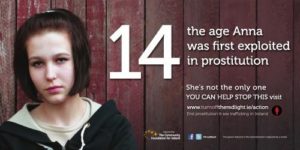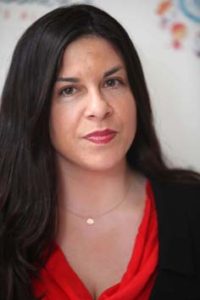Prostitution and the girl child
Sex work proponents continuously create the impression that the adult female sex trade is populated by individual adult women who have made a choice to enter and that the sex trade can be policed to ensure children are not sexually exploited. TORL ensured that these myths were disproved by presenting the extensive research which indicates that choice to enter prostitution is circumscribed by multiple personal and socio-economic risk factors in the lives of girls and young women, which leaves them vulnerable to being recruited and targeted by pimps and traffickers. In a large scale study across nine countries involving 854  interviews with women in prostitution, 47% revealed that they had entered the sex trade before the age of 18.1 In a national study of children at risk of sexual exploitation, the UK children’s charity Barnardos found that the factors that put children and young people at risk are: disrupted family life; a history of abuse and disadvantage; problematic parenting; disengagement from education; going missing; exploitative relationships; drug and alcohol misuse and poor health and well-being.2
interviews with women in prostitution, 47% revealed that they had entered the sex trade before the age of 18.1 In a national study of children at risk of sexual exploitation, the UK children’s charity Barnardos found that the factors that put children and young people at risk are: disrupted family life; a history of abuse and disadvantage; problematic parenting; disengagement from education; going missing; exploitative relationships; drug and alcohol misuse and poor health and well-being.2
TORL highlighted how the global female prostitution market is sustained by adult women as well as under-age girls, who are inserted into the same cycle of exploitation and intended for the same kind of customer, where they are considered as ‘interchangeable goods’.3 International estimates indicate that 10 – 30 per cent of trafficked females are minors, which is reflected in Ireland in that 11% of those trafficked into Ireland for sexual exploitation were minors at the time they were first trafficked.4 As Kelly and Regan (2000) argue, attempts to make a rigid distinction between adult and child prostitution are not sustainable:
‘How can it be that on one day when the young person is 15 or 17 their involvement in the sex industry is exploitation and illegal, but on the next day – their birthday – when they are 16 or 18, this becomes not just legal but legitimate, a matter of choice, a form of work? What process can occur in 24 hours that transforms something inherently exploitative into an issue of choice and consent?’5 (Kelly & Regan, 2000).
Children’s organisations played a vital role in TORL, highlighting the risk to the girl child of being targeted for prostitution and the increasing number of children being trafficked for sexual exploitation.
Below you can hear from June Tinsley of Barnardos about their involvement with the campaign, and read a statement from the Children’s Rights Alliance
| Statement by Tanya Ward for the Children’s Alliance
“The Children’s Rights Alliance unites over 100 members working together to make Ireland one of the best places in the world to be a child. We change the lives of all children in Ireland by making sure that their rights are respected and protected in our laws, policies and services. We have been a member of Turn Off the Red Light since 2012 and are proud to have contributed towards the campaign’s achievements to protect children and women. We signed up to bring a specific child-focus to the campaign. We were – and still are – deeply concerned about the exploitation of children and young people in Ireland’s sex ‘industry’. We also believe that the most effective way to tackle this exploitation is to place a criminal onus on the purchasers of sex rather than on those who are working in prostitution. The Children’s Rights Alliance has a proud history of advocacy to help combat the crimes of child prostitution and child trafficking. For example, we were the Irish partner with The Body Shop global campaign Stop Sex Trafficking of Children and Young People from 2009-2012. 165,000 petition signatures were collected in Ireland calling for stronger laws and services for child victims. In joining Turn Off the Red Light, we hoped that our strong track record in this area would add weight to the campaign as well as a children’s rights perspective. Childhood is a precious time yet the journey into prostitution frequently begins when a young person is under the age of 18 years. In a large scale international study, almost half of women in prostitution (47%) revealed that they had entered the sex trade as children. Many of those who engage in prostitution are often also victims of trafficking. Children are particularly vulnerable members of society to begin with and we know that the demand exists for child prostitutes in particular, so the risks here are huge. Another difficulty that exists is measuring the scale of child prostitution in Ireland. Part of this is due to the hidden and clandestine nature of this crime. But there are also significant research and data gaps on child prostitution and other forms of abuse, something Ireland has been criticised about by the UN Committee on the Rights of the Child. Despite this reality, we know from media reports mostly, that there have been children working in the sex industry and brothels in Dublin, Sligo, Kilkenny and Wexford. The US Trafficking in Persons Report (2011) says that Ireland is a destination, source and transit country for children subjected to sex trafficking. A report by the Immigrant Council of Ireland (2009) showed 11 of the 102 women trafficked were children when they were trafficked to Ireland. There is another group that we are also concerned about. This is unknown numbers of Irish and non-Irish children who may be subjected to paedophile networks and rings, from within and beyond their families. Again, not much is known about this group of children. Prostitution involving a child is child sexual abuse. In domestic law, it is illegal to have sex with a child under the age of 17 years, while a child under 17 years cannot consent to sex. So although strong legislation exists to prosecute child abusers, the demand for child prostitution still leaves vulnerable children at serious risk. Under the UN Convention on the Rights of the Child, children have a right to be protected from abuse, including sexual abuse and exploitation through prostitution, and to be protected from being sold. Linked to this is the Optional Protocol to the Convention on the Sale of Children, Child Prostitution and Child Pornography giving additional protection to children. Yet Ireland is the only European Union Member State that has not yet ratified this. Earlier this year, the UN Committee on the Rights of the Child recommended that this happen as soon as possible so Ireland can fulfil its children’s rights commitments. This urgently needs to happen. Far more is needed to protect and support children who experience abuse through prostitution. This includes the ongoing development of a protective environment that provides child victims with timely, age-appropriate and culturally-sensitive services so they can rebuild their lives. For children in prostitution, much needs to be done. In a nutshell, victims need to be identified and laws need to be enforced. Children need far better supports to prevent them from entering prostitution in the first place and to escape pimps and traffickers when they do. Children are especially vulnerable and everything must be done to protect them. We joined Turn Off the Red Light to make sure this happens. We believe there is strength of numbers and are honoured to join forces with the campaign where we will continue to bring our unique focus on children’s right to the table.” |
Footnotes
1Farley, M., Cotton, A., Lynne, J., Zumbeck, S., Spiwak, F., Reyes, M.E., Alvrez, D., Sezgin, U. (2003). Prostitution and trafficking in nine countries: An update on violence
and post-traumatic stress disorder. In M.Farley (Ed.) Prostitution, trafficking and traumatic stress (pp. 33-74). Haworth Press.
2Barnardos (2007) Whose child now? Fifteen years of working to prevent the sexual exploitation of children in the UK: Believe in children. Barnardos.
3Monzini, P. (2005). Sex traffic: Prostitution, crime and exploitation. London: Zed Books.
4Kelly, L. (2002). Journeys of jeopardy: A review of research on trafficking in women and children in Europe. Vienna: International Organisation for Migration (IOM).
Kelleher Associates, O’Connor M., and Pillinger, J. (2009). Globalisation, sex trafficking and prostitution: The experiences of migrant women in Ireland. Dublin: Immigrant
Council of Ireland.
5Kelly, L. and Regan, L. (2000). Rhetorics and realities: Sexual exploitation of children in Europe. Child and Woman Abuse Studies Unit, (CWASU), London:
London Metropolitan University.
